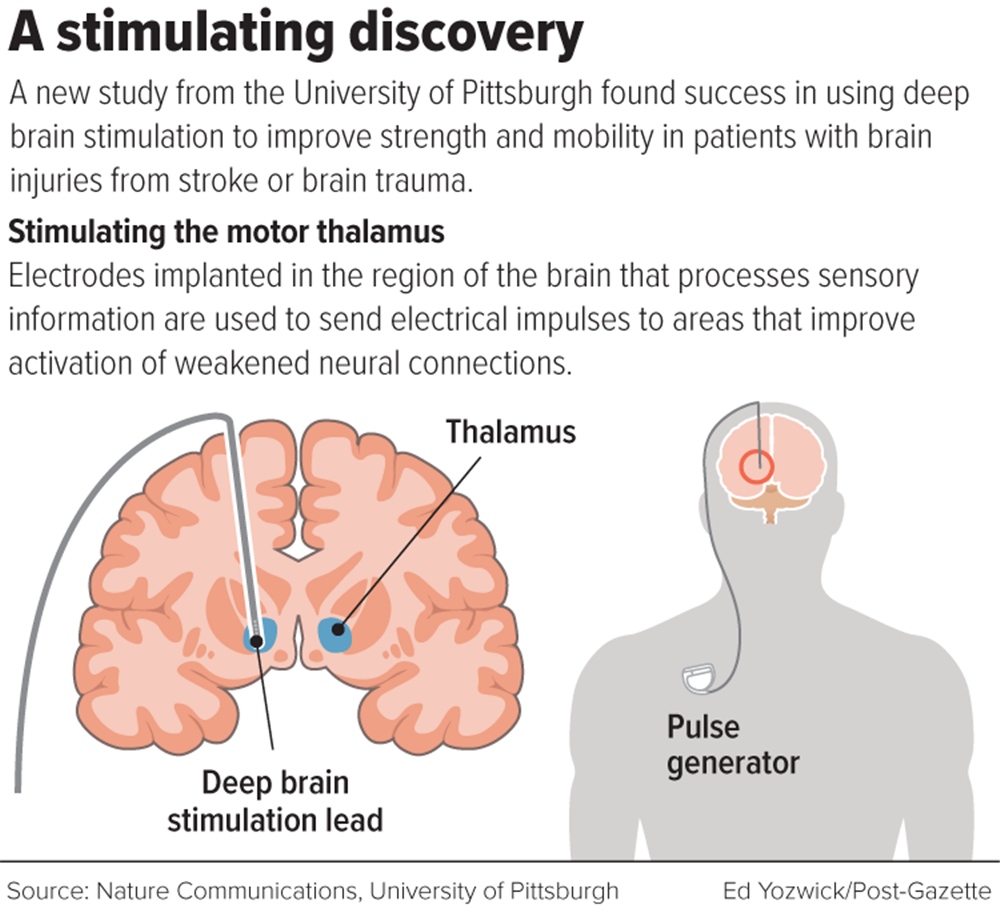Brain injury patients gain arm, hand strength with deep brain stimulation, Pitt study finds
By Anya Sostek / Pittsburgh Post-Gazette
For decades, doctors have used deep brain stimulation, similar to a pacemaker in the brain, to deliver an electrical pulse to help control tremors and seizures.
A new study from Pitt provides evidence that such stimulation can also be used to improve strength and coordination in patients with brain injuries.
“When you turn it on, immediately the patients are stronger and move their arms better,” said Elvira Pirondini, assistant professor of physical medicine and rehabilitation at Pitt. “We believe this has a lot of potential.”
The study, published this month in Nature Communications, began in part by something that surgeons have noticed in the operating room when implanting deep brain stimulation devices for tremors.
“When we put in the DBS, we can see immediately the tremor stopping in the operating room,” said Jorge González-Martínez, vice chair of neurosurgery and director of the epilepsy and movement disorders program at Pitt. “When we started observing those patients, we saw something else — not only do the tremors stop but the arm raises. That was perhaps the idea that this can improve the strength in the arm.”
To test the theory, Pitt researchers first began working with monkeys to determine the best location to stimulate within the motor thalamus, an area of the brain that relays signals about movement. With promising results in monkeys, the researchers moved on to testing the effects of the stimulation in humans, using seven people who were already receiving deep brain stimulation for existing health issues.
Researchers used electrodes on the arm, hand and finger muscles to measure the amount of muscle reaction in response to the electrical stimulation, determining that the optimal frequency of stimulation to increase muscle function is lower than the frequency currently used to control tremors.
“It’s a technicality,” said Pirondini, senior and corresponding author of the study, “but it was something really important for achieving the result we achieved.”
The researchers were able to test the effects of the stimulation on one subject with movement deficiencies due to a traumatic brain injury. They found immediate and significant improvements. Before the stimulation, the subject had “severe difficulty” performing the everyday task of grasping a cup, drinking from it and releasing it. Once the stimulation was turned on, he was able to “smoothly” perform all of those tasks.
In a separate task, the subject was also able to lift his arm higher while holding a weight immediately after the stimulation than he was before.
The research team at Pitt is now further refining its methods with more subjects, testing the deep brain stimulation technology in more than 20 subjects. Pitt recently received funding to conduct a clinical trial of the deep brain stimulation technique and is recruiting patients between 18 and 75 who had a stroke more than six months ago resulting in moderate to severe speech issues.
Some of the results with the patients they have tested in their work so far have been so immediate that subjects and their families have cried with their newfound ability to perform tasks, or speak more clearly.
González-Martínez remembers one family’s reaction when the subject called them during stimulation.
“They were very emotional,” said González-Martínez. “They could now understand what he was saying on the phone. They have the hope that this will change their lives.”
